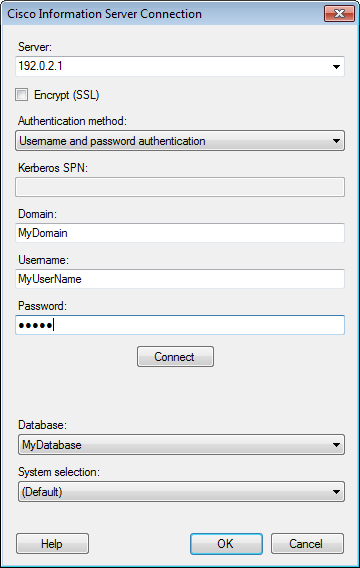
This dialog is used to connect to a Cisco Information Server, where you can analyze data from different data sources (e.g. Oracle, Teradata, Salesforce.com, etc.), either in-database or by importing it into your analysis. Note that you need to install a driver on your computer to get access to the Cisco Information Server connector. See the system requirements at http://support.spotfire.com/sr_spotfire_dataconnectors.asp to find the correct driver. You can also view Getting Started with Connectors to learn more about getting access to connectors in Spotfire.
To add a new Cisco Information Server connection to the library:
Select Tools > Manage Data Connections.
Click Add New > Data Connection and select Cisco Information Server.
To add a new Cisco Information Server connection to an analysis:
Select File > Add Data Tables....
Click Add.
Select Connection To > Cisco Information Server.

Option |
Description |
Server |
The name of the server where your data is located. To include a port number, add it directly after the name preceded by colon. Example with port number: |
Encrypt (SSL) |
The Cisco Information Server connector has SSL support. |
Authentication method |
The authentication method to use when logging into the database. Choose from Username and password authentication, Kerberos authentication and NTLM authentication. Username and password authentication With Username and password authentication the authentication is done using a database user. Database credentials can be stored, unencrypted, as part of the analysis file, using a setting in the Data Source Settings dialog. If credentials are found in the analysis file they will be used to automatically authenticate against the database. If no credentials or credentials profiles are found in the analysis file all who open the file will be prompted for database credentials. Note that there will be no prompting for credentials if the credentials embedded in the analysis file fail. Kerberos authentication When using Kerberos authentication the access token of the logged in user will be used. Users that have been given the appropriate access rights to Cisco Information Server will be able to connect and read data. Domain credentials are not stored in the analysis file. NTLM authentication When using NTLM authentication, the access token of the logged in user will be used. Users that have been given the appropriate access rights to Cisco Information Server will be able to connect and read data. Domain credentials are not stored in the analysis file. |
Kerberos
SPN |
[Only applicable when using Kerberos authentication.] The service principal name (SPN) used to identify the Kerberos authentication service. |
Domain |
[Only applicable when using Username and password authentication.] The authentication domain to use when logging into the Cisco Information Server system. |
Username |
The username you wish to use when logging into the Cisco Information Server system. |
Password |
The password for the specified username. |
Connect |
Connects you to the specified server and populates the list of available databases below. |
Database |
Select the database of interest from the drop-down list. |
System selection |
Define
the underlying database system to allow more aggregation methods
than the five basic ones available in SQL: Sum, Avg, Min, Max
and Count. |
See also:
Cisco Information Server Data Types